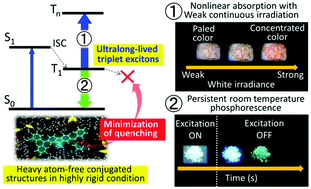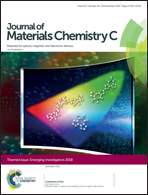Ultralong-lived room temperature triplet excitons: molecular persistent room temperature phosphorescence and nonlinear optical characteristics with continuous irradiation
Abstract
Heavy atom-free conjugated molecules tend to display triplet exciton lifetimes longer than one second only at liquid nitrogen temperature because nonradiative deactivation of the triplet state is usually rapid at room temperature (RT). This review summarizes recent progress of molecular materials with long triplet exciton lifetimes at RT. Recent careful photophysical analyses indicated that the fast nonradiative deactivation of the triplet state of heavy atom-free conjugated molecular guests in solid hosts with large triplet energy was caused by not intramolecular vibrations of the guests but endothermic energy transfer from the guests to the host and quenching by oxygen in the host. Minimization of both energy transfer and quenching using a highly rigid molecular host realized ultralong-lived RT triplet excitons for many heavy atom-free conjugated structures. The discovery of such host–guest materials triggered the emergence of several kinds of molecular materials with ultralong-lived RT triplet excitons. These materials showed novel functions like nonlinear absorption characteristics and persistent RT phosphorescence. A variety of new applications using such molecular materials have been demonstrated in the past five years.

- This article is part of the themed collections: Recent Review Articles and Journal of Materials Chemistry C Emerging Investigators


 Please wait while we load your content...
Please wait while we load your content...